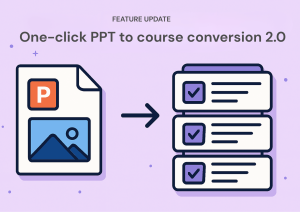
True Cost to Train a New Employee: What You Need to Know
- Author: Urban Rotar
- Published:

What are the main factors that impact the cost of training a new employee?
The main factors include recruitment and advertising expenses, background checks, equipment costs, productivity loss during training, company size, type of training, and the new employee’s existing skill set.
How can businesses reduce the overall cost of training new employees?
Businesses can reduce costs by implementing skills-based hiring, using on-the-job training, employing microlearning tools, outsourcing training development, leveraging technology, and creating repeatable and scalable onboarding programs.
Why should training costs be viewed as an investment rather than an expense?
Training should be seen as an investment because it leads to improved employee retention, higher productivity, and long-term cost savings. Investing in employee development enhances their skills and engagement, which benefits the company’s overall success and profitability.
Key Takeaways - Cost to Train a New Employee:
- Understanding Training Costs: Training costs include direct expenses, productivity losses, and hidden costs like time spent and materials.
- Factors Influencing Training Costs: Recruitment strategies, background checks, company size, and training type significantly impact overall training expenses.
- Hidden Costs of Employee Training: These can quickly add up, including employee attrition, which can cost up to twice an employee’s annual salary.
- Reducing Training Costs: Implementing on-the-job training, microlearning, and onboarding software can significantly lower training expenses.
- Training as an Investment: Viewing training as an investment leads to better employee retention and productivity, ultimately benefiting the company’s bottom line.
Understanding Training Costs
Training costs encompass a range of expenses that go beyond just the training materials. They include the time spent by current employees to train new hires, the cost of training resources, and potential productivity losses. Properly accounting for these costs is crucial for businesses to budget effectively and understand the true cost of training. It is essential to determine how much training each employee requires to accurately calculate the overall training costs. Lower costs cab also be achieved with the help of AI authoring tools and content creators.
Factors that Impact Training Costs
Several factors can influence the total training costs for a new employee:
Recruitment Strategy and Advertising the Position: Job board fees vary wildly depending on the site used, and effective recruitment strategies can reduce overall costs. An efficient hiring process, including thorough background checks and skills assessments, can significantly reduce overall training costs.
Background Checks and New Equipment Costs: Budget for the time and expense of background checks and new equipment needed for the job.
Productivity Loss Incurred During Training: On average, a typical mid-level manager needs 6.2 months to become fully productive.
The Size of the Company: Larger companies have lower costs and smaller companies have higher costs, due to economies of scale.
The Type of Training: Different training types have different associated costs, including instructor-led training, on-the-job training, and learning technologies.
The Employee’s Skill Set: The amount of training an individual needs is dependent on their existing knowledge and skill set.
The Hidden Costs of Employee Training Costs
Beyond the obvious expenses, there are hidden costs associated with employee training that can add up quickly. These include:
Training expenditures can include a variety of hidden costs, such as materials, time spent, and productivity losses. It is also of critical importance to track the improvements and measure the employee training outcomes in order to have a clearer bigger picture.

Employee Attrition and Its Impact
The cost of replacing an individual employee can range from one-half to two times the employee’s annual salary. High employee attrition rates can lead to substantial costs for businesses. Good employee retention rates help to boost morale, maintain a good customer experience, encourage productivity and innovation, and reduce overall costs.
Skills Testing and Its Role in Reducing Costs
Skills-based hiring practices screen and hire new employees based on their skills, capabilities, and talent. This approach encourages continuous learning and gives opportunities to people with self-taught skills. Skills-based hiring reduces the time it takes to onboard and train new employees, ultimately lowering training costs.
On the Job Training: A Cost-Effective Approach
On-the-job training can be an incredible training tool that brings the cost of training new employees down. Because this type of training is specialized and focused on the specific tasks they’ll perform, employees can immediately see the value of the information.
Effective on-the-job training can significantly reduce the overall cost of training a new hire.
Creating a Seamless Onboarding Experience
Relevant, targeted, and timely on-the-job training can reduce the average training cost per employee. Creating a seamless onboarding experience is crucial, as it helps new employees integrate quickly and efficiently into the company.
Calculating the Training Cost per Employee
To calculate the training cost per employee, factor in all possible training costs, including hidden costs and productivity loss. The formula for calculating the training cost per employee is: Training Cost Per Employee = Total Training Expenses / Number of New Employees. This calculation provides a clear picture of the investment required for effective employee training. Training expenditures should be carefully calculated to ensure an accurate understanding of the investment required for effective employee training.

Considering Hidden Costs and Productivity Loss
Consider all potential hidden costs when calculating training expenses, including the impact on the employee’s annual salary. This includes productivity loss, which can be substantial if new employees take a long time to become fully productive. Creating repeatable programs that cover the basics for every employee and offering specialized training only to those who need it can help manage these costs.
Creating a Repeatable and Scalable Onboarding Program
Use checklists of employee procedures to create a record of training, and make sure all managers know what steps to take (and in what order!). This systematic approach ensures consistency and efficiency in training new hires.
Strategies for Reducing Training Costs
Implementing cost-effective training strategies can help reduce overall expenses.
Implementing cost-effective training strategies can help reduce the overall cost of training a new hire. Try to optimise the whole learning process with the addition of the Learning Management System (LMS).

Implementing Microlearning Tools and Outsourcing Training Development
Microlearning is a cost-effective type of training that provides training right when an employee needs it. This style of training has been shown to help employees retain more knowledge, over a longer period of time. Even if you have the best instructional design and training team, you’ll sometimes need to outsource your eLearning to manage costs effectively.
Creating Better Training, Faster and More Efficiently
Most eLearning courses fall somewhere between levels one and two, which take between 42 and 71 hours to develop. Finding ways to streamline the development process can help create these courses faster and more efficiently, reducing overall training costs.
The Role of Technology in Reducing Training Costs
Technology can play a significant role in reducing the cost of training new employees.
Technology can also streamline the hiring process, making it more efficient and cost-effective.

Using Onboarding Software to Save Time and Money
Onboarding software can reduce onboarding costs by setting up time-saving tasks. It supports a comprehensive onboarding strategy, leading to a better investment for the business.
Creating a More Efficient Training Process with Technology
Technology-based training has lower costs as it doesn’t require an instructor or travel. Learning management systems can help streamline the training process and reduce costs, making it an effective solution for many businesses.
Is the Cost of Training Employees Worth It?
Investing in employee training can provide significant long-term benefits for a business.
Considering the overall employee cost, including training and other expenses, is crucial for making informed investment decisions.

Weighing the Benefits of Investing in Employee Training
Successfully training employees can save you money in the long run by improving employee retention. Improper training can lead to high employee turnover, which can cost your business money. Therefore, investing in comprehensive training programs is essential.
Reframing Training as an Investment in the Company’s Future
Training should be regarded as an investment rather than a cost, with a clear ROI expectation set at the start. Employees are an appreciating asset, and investing in upskilling existing talent is smarter and more cost-effective than sourcing new talent.
Conclusion: The True Cost of Training a New Employee
Understanding and managing the true cost of training a new employee involves considering numerous factors, including direct expenses, hidden costs, and productivity losses. Calculating these costs accurately ensures that businesses can make informed decisions about their training investments. Effective onboarding processes are essential for reducing the overall cost of training a new hire.
The true cost of training a new employee involves many components, including salary, training, and other expenses. Calculating the cost of a new employee requires considering various factors, including the role, industry, and candidate’s level of experience.
The cost of training new employees provides a significant ROI and protects the health of your bottom line. For an investment of just 10% of an employee’s salary (or less!), you can help create employees who excel in their work and are invested in the success of your company.



